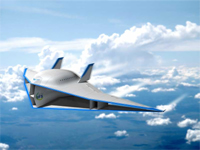
As the background, I have been working on the biplane concept in order to
design a low boom supersonic aircraft; the concept allows a significant reduction,
if not complete elimination, of sonic boom by use of the Busemann type biplane.
In forging ahead with the design of the supersonic biplane, it is necessary to develop
a fundamental technology of the biplane, and also to evaluate the sonic boom influence on the ground.
The abstracts of my researches are as follows.
Numerical Investigation of the Realistic Impact on the Sonic Boom under
the Real Meteorological Condition (07/2008-present):
This study investigates the realistic impact of sonic boom under the real
meteorological condition on sonic boom intensity. As a first step to investigate the impact,
the sonic boom intensity was calculated with temperature gradient in many parts of the world,
without winds. The temperature gradients were obtained by radiosonde,
and the near field pressure wave of Sears-Haack body obtained from CFD was
employed in this research. Then, sonic boom was extrapolated through the
observed temperature gradient. Results show that there is a trend of seasonal
variations in boom intensity. In addition, we observed a certain correlation
between the sonic boom intensity and the ground temperature.
For future work, I would like to clarify the correlation between the boom
intensity and the realistic meteorological conditions.

Global distribution maps of variations in sonic boom intensity throughout the world for each season north of 60S in 2007: (a) JJA (June, July, and August; northern summer) and (b) DJF (December, January, and February; northern winter). In both figures, the contours represent the differences in sonic boom intensity between the value for each observation point and that of the standard atmosphere. The contour interval is 0.025.
Sonic Boom Propagation with Atmospheric Fluctuations of Wind and Temperature (01/2008-present) [Ref.1]:
This study describes the non-deterministic effects of wind and temperature fluctuations
on sonic boom propagation. The Sears-Haack body was calculated in three-dimensions by use
of Computational Fluid Dynamics (CFD) in inviscid flow (Euler) mode, in order to create the
near-field pressure wave. Then, the sonic boom signature was calculated by the modified
Waveform Parameter Method, considering both fluctuations, respectively. The fluctuations
were represented by a finite sum of discrete Fourier modes with the von Karman and Pao
energy spectrum. Results show that the fluctuations have a great influence on sonic boom
intensity during its propagation towards the ground. As compared to the non-fluctuation case,
both fluctuations seem to favor a decrease in boom intensity, rather than increase it.
In addition, both fluctuations have a considerably small effect in changing the propagation
paths from the flight altitude to the ground. Nonetheless, this small change in the propagation
path may result in a variability of the position where the sonic boom reaches the ground.
For future work, I would like to create the prediction model of turbulent distortion.

Sketch of the coordinate system for the present model. The solid line shows a ray path of sonic boom through a wind fluctuation field, propagating from the flight path to the ground.

Distribution of initial overpressures for the 100 cases calculated with wind fluctuation. The bin size is 0.25.
Numerical Investigation on Sonic Boom Reduction with Non-axisymmetric Body Shapes (04/2007-present) [Refs.5,6]:
This study describes the possibility for reducing the sonic boom by using non-axisymmetric
body shapes, which are expected to take advantage of the cut-off phenomenon of the atmosphere
more efficiently. If the propagation of high pressure shock waves can be restricted above
the cut-off range, the sonic boom heard on the ground can be considerably alleviated.
Therefore, a non-axisymmetric body shape was employed to create this asymmetric propagation
of near-field pressure waves. In this research, Triangle body, Diamond body, and four ideal
bodies of revolution were studied and their initial boom intensities were compared.
Near-field pressure and sonic boom signatures were examined quantitatively, using Computational
Fluid Dynamics (CFD) in inviscid flow (Euler) mode and the Waveform Parameter Method.
As for the results, the Triangle body in lift condition realized the asymmetric propagation
and also the utilization of the cut-off phenomenon. Thus, the boom intensity on the ground was
alleviated as much as the 1/4th power body with a blunted-nose shape at no-lift condition.
Reduction of Drag Penalty by means of Plain Flaps in Boomless Busemann Biplane (04/2005-03/2007) [Refs.2,4,8,9,12]:
This study describes a method to overcome the choked-flow and flow-hysteresis problems of
the Busemann biplane at off-design conditions, by using plain flaps at the leading and trailing edges.
Two-dimensional analyses of four different biplanes were addressed in order to examine the effect
of the flaps, using Computational Fluid Dynamics (CFD) in inviscid flow (Euler) mode.
Results show that the leading-edge flaps can alleviate the drag increase due to the choked-flow,
and reduce the area of flow-hysteresis. In contrast, the trailing-edge flaps are not effective
in overcoming these problems. However, the trailing-edge flaps can reduce the wave drag near
to the speed of sound, and also shift the drag-divergence Mach number to a higher one.
Thus, the combined effect of both flaps allows us to smoothly achieve the design point (M = 1.7)
from subsonic regime, and to avoid the severe drag penalty due to the choked-flow and
flow-hysteresis problems.



